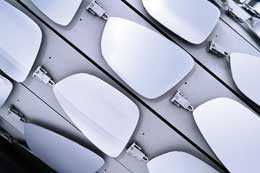18 November 2013
UniSA hosts Materials Innovations in Surface Engineering (MISE) conference 2013
 Australian innovation focussed on engineering high performing materials could lift Australian manufacturing out of the doldrums.
Australian innovation focussed on engineering high performing materials could lift Australian manufacturing out of the doldrums.
The sector has seen a decline in its contribution to the GDP from 25 per cent to just 10 per cent, but industry and research experts meeting at the University of South Australia this week believe high tech innovations in materials and surface engineering hold the key to reinvigorating the industry and they already have runs on the board to prove it.
On 19-21 November national and international research scientists will come together with industry representatives at the UniSA’s Mawson Lakes campus for the Materials Innovations in Surface Engineering (MISE) conference.
Surface engineering involves the modification of a material’s surface through the application of organic and inorganic compounds, heat treatment, chemical vapour deposition, alloy or polymer selection and other methods, to improve its performance.
The technology has applications across a variety of industries including the automotive, defence and biomedical sectors.
Already many local innovations in surface engineering are being commercialised with great success including work done by researchers at UniSA’s Mawson Institute in collaboration with automotive parts manufacturer SMR to develop the world’s first rear-view mirror made entirely of plastic.
Research group leader for the plastic mirror project Associate Professor Peter Murphy will be presenting a brand new technological innovation at the conference, in the area of high reflectivity coatings for concentrated solar power.
A specialist in the application of thin film coatings to plastic substrates with more than 20 years of experience working with thin film coatings, Assoc Prof Murphy says the conference provides an opportunity to showcase the exciting and productive collaborations between universities and industry.
“Working with national and international companies, it is our focus to transition research from the laboratory into commercial product with all the associated benefits to the economy, including local jobs,” Assoc Prof Murphy said.
“The high reflectivity coatings we have been developing have many applications in the real world, from mirrors on concentrated solar power mirrors to LED headlights for cars – their potential is significant.”
Assoc Prof Murphy joins a number of speakers with significant experience in the commercialisation of high-tech surface and materials innovations at the conference, including Dr Torsten Schmauder, a leading researcher working with German optical coatings firm Leybold Optics.
Dr Schmauder will open the conference alongside South Australia’s Chief Scientist Professor Don Bursill, with a discussion on the application of vacuum-coated thin films in surface engineering.
“Conferences like the MISE are extremely important to get input on what will be needed by industry and what is being developed by UniSA and other Institutes,” Dr Schmauder said.
Other speakers include Professor Magnus Nyden, Director from UniSA’s Ian Wark Research Institute, who has been also developing surface engineering advances with significant commercial benefits.
Prof Nyden’s work on the development of anti-fouling coatings for applications in the maritime industry stands to save time and resources in the removal of biomaterials from marine craft.
His work in the lab has led him into the boardrooms of two companies as the Director of SuMo Biomaterials and an associate of marine paint supplier Capeco AB.
“Our coating is intended to be cheap, non-toxic and applicable on large surfaces, for instance on a ship or submarine hull. Our goal is to develop technologies using polymer materials intended for large-scale production in South Australia,” Prof Nyden said.
The conference will also host a number of representatives from local and global industry groups including United Surface Technologies, Kennametal Australia and Austral Technologies and Iranian MAPNA Group.
Government bodies including CSIRO, DSTO and the Australian Submarine Corporation, the provider of maintenance services to Australia’s naval defence submarines will also attend.
Mikael Johansson from the Australian Submarine Corporation says the innovation and development of new anti-fouling technologies based on Stimuli-Responsive Copper Scavenging Polymer Films are just one example of the promise of research and industry collaboration.
“This is very interesting technology that will enable a more environmentally friendly anti-fouling solution with the potential to have improved reliability compared to existing systems,” Johansson says.
“It is also an example of home-grown innovation that can support the development of local industries.”
For more information about the conference or to register please visit: materialsaustralia.com.au
Media contact: Michèle Nardelli office: 08 8302 0966 mobile: 0418 823 673 email: Michele.nardelli@unisa.edu.au



